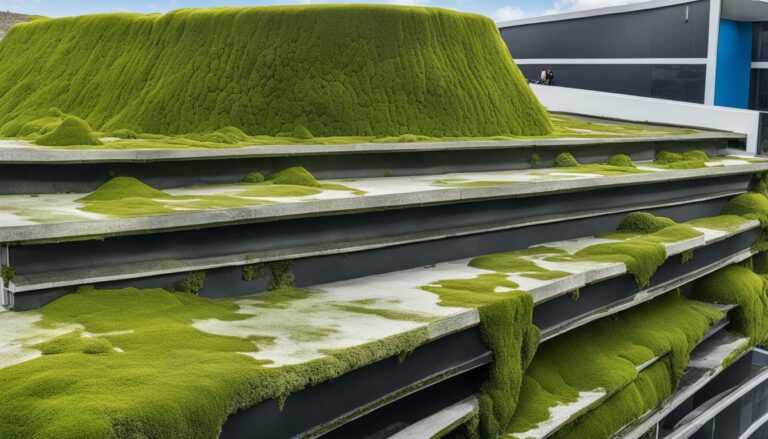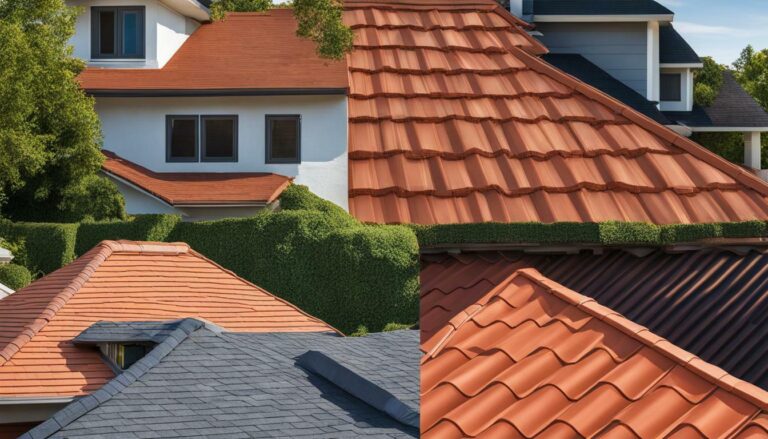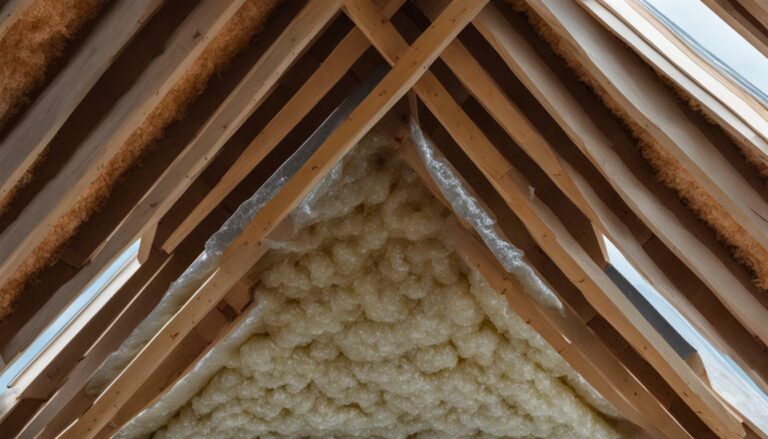Your Guide to Eco-friendly Roof Disposal in the United States
If you’re looking for a comprehensive guide on eco-friendly roof disposal in the United States, you’ve come to the right place. Responsible roof disposal is crucial for reducing environmental impact and preserving the planet for future generations. In this guide, we will explore different sustainable roof disposal methods and highlight the importance of recycling roofing materials.
Key Takeaways:
- Metal roofing materials like Galvalume®, galvanized steel, aluminum, copper, zinc, and stainless steel can be 100% recycled.
- Asphalt shingles can be recycled to create pavement for roads, new asphalt shingles, or covers for grounds.
- EPDM rubber roofing can be recycled through specialized programs, with the recycled materials used in waterproofing materials and coatings.
- Concrete and clay tile roofing can be easily crushed into gravel and repurposed for various construction projects.
- Recycling roofing materials helps reduce carbon footprint and can contribute to LEED certification.
In addition to choosing eco-friendly roofing materials, it is essential to ensure sustainable practices throughout the entire roofing process. This includes sourcing materials from responsible suppliers, looking for certifications like FSC-certified wood, and considering the local availability of materials to minimize transportation-related environmental impact.
Remember, while no roofing material is entirely sustainable, opting for durable, energy-efficient materials and disposing of them responsibly can go a long way in minimizing the environmental footprint.
Understanding Eco-friendly Roofing Materials
Before diving into the specifics of eco-friendly roof disposal, it’s important to understand the range of roofing materials that can contribute to a greener environment. By choosing sustainable options for your roof, you can reduce your carbon footprint and make a positive impact on the planet. Here are some environmentally-friendly roofing materials to consider:
- Metal Roofing: Metal roofing is 100% recyclable, including the most common types such as Galvalume®, galvanized, aluminum, copper, zinc, and stainless steel. By using pre-consumer and post-consumer recycled materials, metal roofs can be an excellent choice for sustainable roof designs.
- Asphalt Shingles: While asphalt shingles are not typically considered eco-friendly due to their petroleum-based composition, they can be recycled at qualified recycling centers. This process allows them to be used in the creation of pavement for roads, new asphalt shingles, or even covers for grounds. Raising awareness about shingle recycling services among contractors and installers is essential to encourage responsible disposal.
- EPDM Rubber Roofing: EPDM rubber roofing can be recycled through specific programs that collect tear-offs and transport them to recycling centers. The recycled EPDM can then be used in the production of waterproofing materials and coatings, reducing waste and promoting sustainable practices.
- Concrete or Clay Tile Roofing: Concrete and clay tile roofing materials can be easily recycled after reaching the end of their lifespan. These durable materials can be crushed into gravel and repurposed in various construction projects, including sidewalks, walkways, and landscaping designs. Recycling these materials ensures their proper disposal and minimizes environmental impact.
Choosing sustainable roofing materials goes beyond just the composition of the roof. It also involves considering factors such as longevity, energy efficiency, and recycling practices. Metal roofs, for example, have a longer lifespan compared to traditional asphalt shingles, reducing the need for replacement and waste generation. Furthermore, looking for certifications like FSC-certified wood or Energy Star ratings for heat reflectivity can help ensure that materials are sustainably sourced and contribute to a more eco-friendly roof.
By making informed choices about your roofing materials and implementing responsible disposal practices, you can play a part in creating a more environmentally-friendly future. Remember that no roofing material is truly sustainable, but by prioritizing durability, energy efficiency, and proper disposal, you can minimize the environmental impact of your roofing choices.
Related image:

Recycling Metal Roofing Materials
Metal roofing is known for its durability and longevity, but did you know that it can also be recycled in an eco-friendly manner? Whether you have Galvalume®, galvanized, aluminum, copper, zinc, or stainless steel roofing, these materials can be recycled after their use, contributing to responsible roof disposal and reducing waste.
By recycling metal roofing materials, you not only prevent them from ending up in landfills but also conserve valuable resources. Pre-consumer and post-consumer recycled materials can be used to manufacture new metal products, reducing the need for virgin resources and the associated environmental impact.
To recycle your metal roofing, contact your local recycling center or scrap metal yard. They will be able to guide you on the proper process of recycling your specific type of metal roofing material. Some centers may offer pickup services for larger quantities, making it more convenient for contractors and homeowners alike.
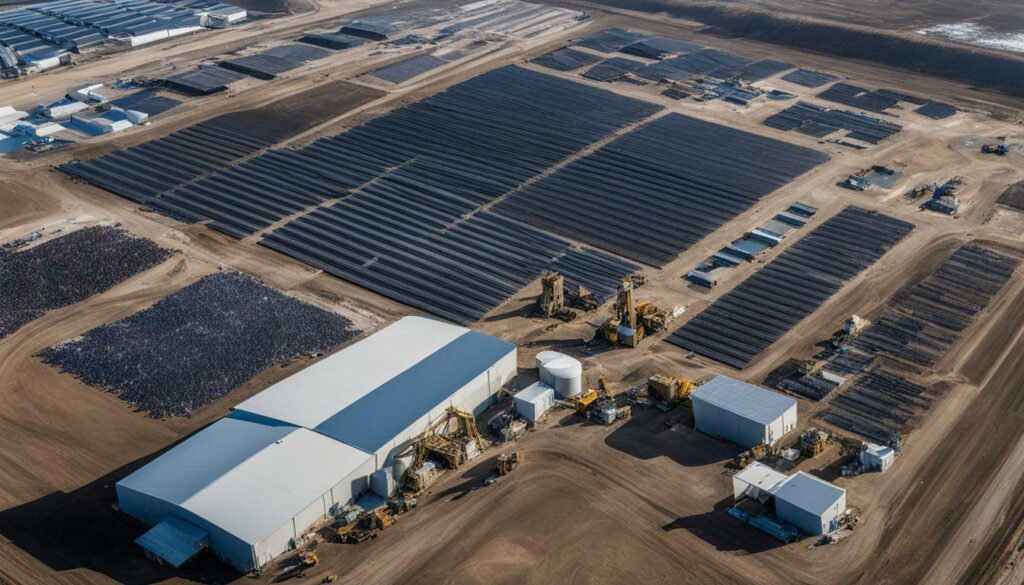
Recycling metal roofing materials is not only environmentally friendly but also economically advantageous. The scrap metal industry provides a market for recycled metal, which helps create jobs and supports a circular economy. So, when it comes to replacing your metal roof, remember to choose a responsible roof disposal method and contribute to a greener future.
| Benefits of Recycling Metal Roofing Materials | How to Recycle Metal Roofing Materials |
|---|---|
| Reduces waste and landfill space | Contact your local recycling center or scrap metal yard |
| Conserves valuable resources | Inquire about pickup services for larger quantities |
| Supports a circular economy and job creation | Follow their guidelines for proper recycling |
Quote:
“By recycling metal roofing materials, we can reduce waste, conserve resources, and support a circular economy. It’s a win-win situation for the environment and the economy.” – Eco-conscious homeowner
Recycling Asphalt Shingles
Asphalt shingles are a common roofing material, but disposing of them in an eco-friendly way is crucial for reducing waste and promoting sustainability. Fortunately, there are recycling options available for asphalt shingles that can help mitigate their environmental impact.
Qualified recycling centers can process asphalt shingles and repurpose them in various ways. One method is to recycle the shingles to create pavement for roads, which helps reduce the need for extracting and processing new raw materials. Additionally, the recycled asphalt shingles can be used to manufacture new asphalt shingles, closing the recycling loop and minimizing waste.
Another sustainable solution for recycling asphalt shingles is to turn them into ground covers. By grinding the shingles into small pieces, they can be used to cover pathways, playgrounds, or other outdoor surfaces. This not only prevents the shingles from ending up in landfills but also provides a durable and cost-effective alternative to traditional ground covers.
By embracing eco-friendly roof waste management and opting for sustainable roof disposal solutions, we can significantly reduce the environmental impact of asphalt shingles and contribute to a more sustainable future.
Recycling Asphalt Shingles – A Step Towards Sustainability
| Advantages of Recycling Asphalt Shingles | Disadvantages of Landfill Disposal |
|---|---|
|
|
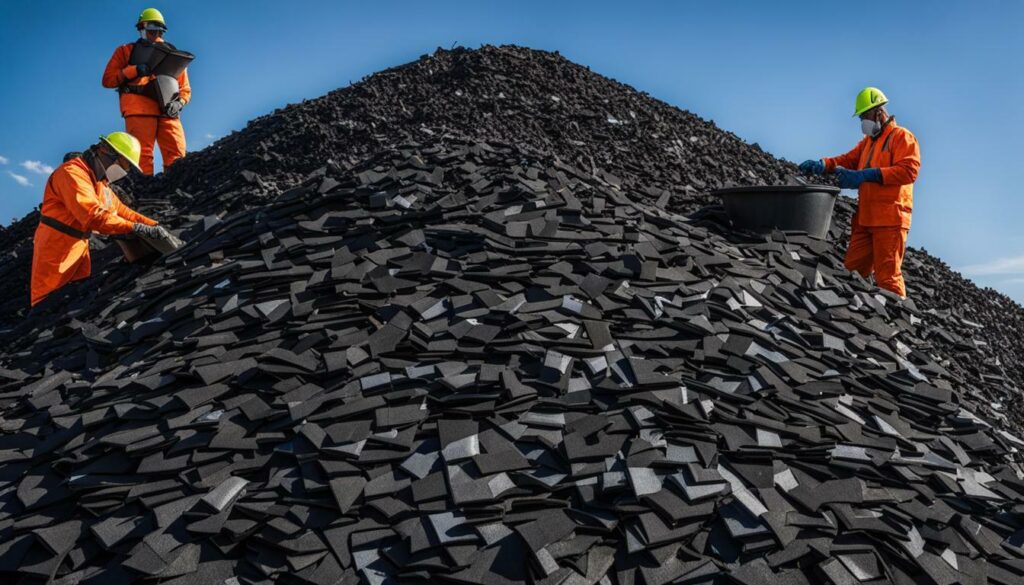
By understanding the importance of sustainable roof disposal methods and actively participating in asphalt shingle recycling programs, we can make a positive impact on the environment and move towards a more eco-conscious future.
Recycling EPDM Rubber Roofing
EPDM rubber roofing is a popular choice for its durability, and knowing how to dispose of it in an eco-friendly manner ensures its contribution to a greener future. Fortunately, there are specific programs available for recycling EPDM rubber roofing, making it a sustainable option for both homeowners and contractors.
EPDM tear-offs can be collected and transported to recycling centers, where they are processed and transformed into a variety of useful materials. One of the main uses for recycled EPDM is in the production of waterproofing materials and coatings. By recycling EPDM, you not only prevent it from ending up in landfills but also contribute to the conservation of natural resources.
Recycling EPDM rubber roofing not only helps reduce waste and conserve resources but also has a positive impact on the environment. By choosing to recycle, you are actively reducing the carbon footprint associated with the production and disposal of roofing materials.
To ensure the proper disposal of EPDM rubber roofing, it is important to work with reputable recycling programs and centers that have the necessary infrastructure and processes in place. By participating in these recycling initiatives, you can take a proactive step towards a more sustainable roofing industry.
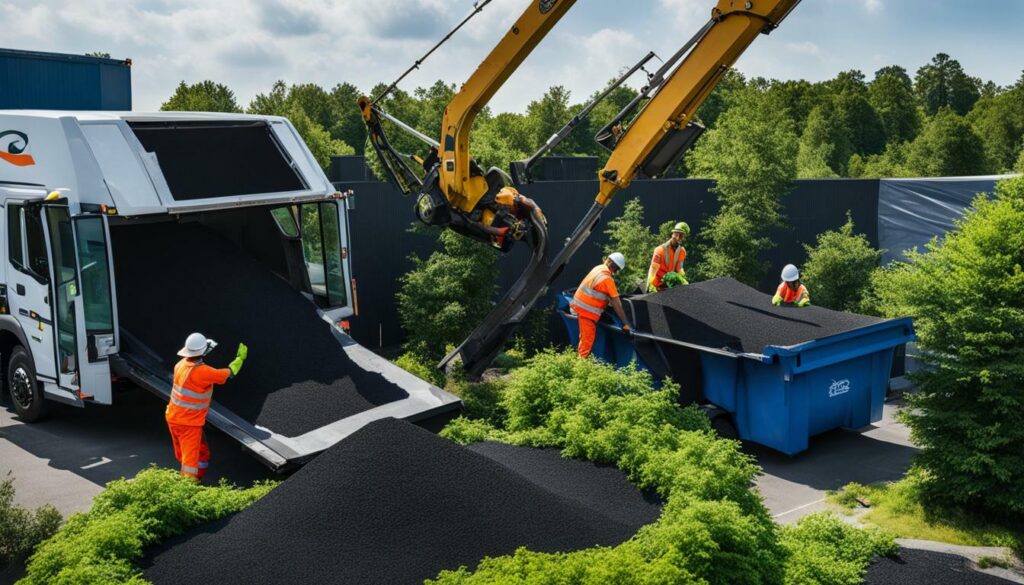
| Benefits | Explanation |
|---|---|
| Reduces landfill waste | Recycling EPDM prevents it from clogging landfills and taking up valuable space. |
| Conserves natural resources | By recycling EPDM, the need for virgin materials is reduced, preserving natural resources. |
| Reduces carbon footprint | Recycling EPDM helps decrease greenhouse gas emissions associated with the production of new roofing materials. |
| Promotes sustainability | Choosing eco-friendly roofing options like EPDM helps create a more sustainable built environment. |
By recycling EPDM rubber roofing, you not only minimize waste but also contribute to a circular economy where materials are reused or transformed into new products. It’s a small but significant step towards a greener future for the roofing industry.
Recycling Concrete and Clay Tile Roofing
Concrete and clay tile roofing are not only aesthetically pleasing but also easily recyclable, making them a sustainable choice for environmentally-conscious homeowners. When these roofing materials reach the end of their lifespan, they can be recycled into new products, reducing waste and minimizing environmental impact. By choosing concrete or clay tile roofing, you can contribute to responsible roof disposal and eco-friendly roof recycling in the United States.
Recycling concrete and clay tile roofing is a straightforward process. Once removed from a building, the materials can be crushed into gravel, which can then be used in various construction projects. This includes the creation of sidewalks, walkways, and even landscaping design. The versatility of recycled concrete and clay tile allows for their integration into new structures, promoting a circular economy and conserving natural resources.
Not only does recycling these roofing materials contribute to responsible roof disposal, but it also helps to reduce carbon footprint. By diverting concrete and clay tile waste from landfills, greenhouse gas emissions associated with waste decomposition are minimized. This eco-friendly practice aligns with sustainable goals and can contribute to achieving LEED certification for both residential and commercial buildings.
To ensure that concrete and clay tile roofing materials are recycled responsibly, it is crucial to work with qualified recycling centers. These facilities have the necessary equipment and expertise to collect, process, and repurpose the materials efficiently. By partnering with these recycling centers, you can be confident that your old roofing materials will be transformed into new products, further supporting eco-friendly roof recycling in the United States.
In conclusion, concrete and clay tile roofing offer more than just aesthetic appeal. They are easily recyclable, contributing to responsible roof disposal and eco-friendly roof recycling. By choosing these sustainable roofing materials and working with qualified recycling centers, you can minimize waste, reduce carbon footprint, and promote a greener future for the United States.
| Benefits of Recycling Concrete and Clay Tile Roofing | How It Helps |
|---|---|
| Reduces waste | By recycling old roofing materials, waste is diverted from landfills, minimizing environmental impact. |
| Conserves resources | Recycled concrete and clay tile can be used in various construction projects, reducing the need for virgin materials. |
| Minimizes carbon footprint | Reusing these materials reduces greenhouse gas emissions associated with waste decomposition. |
| Promotes circular economy | Recycling concrete and clay tile roofing supports a sustainable approach to resource management. |
Quote:
“By choosing concrete or clay tile roofing and ensuring responsible recycling, homeowners can make a positive impact on the environment while enjoying the durability and aesthetic appeal of these materials.” – Environmental Roofing Solutions
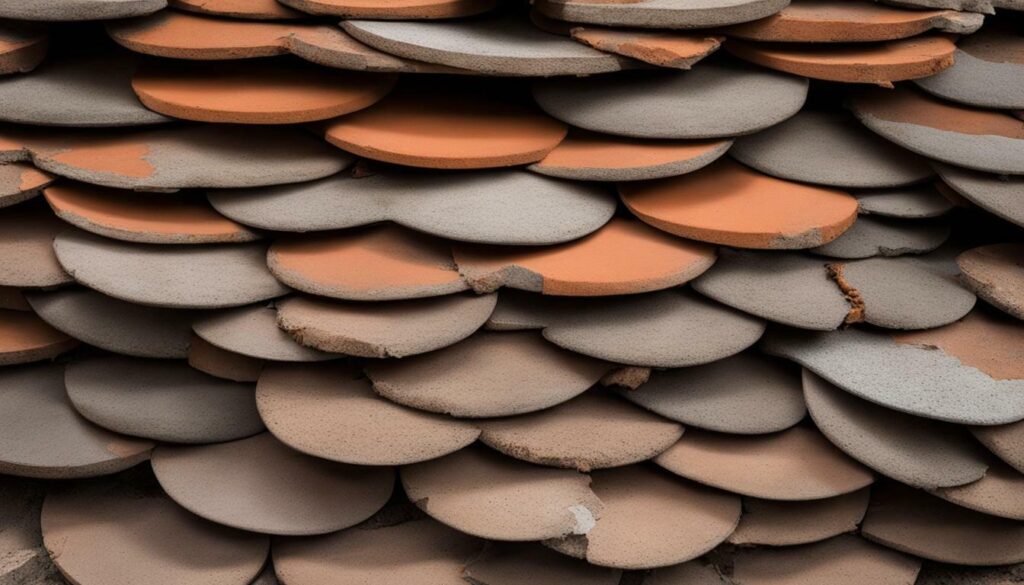
Recycling roofing materials goes beyond waste management; it has significant environmental benefits, including reducing carbon footprint and promoting sustainability. By choosing to recycle rather than dispose of roofing materials, you can contribute to a greener future for the United States.
One of the main environmental advantages of recycling roofing materials is the reduction of carbon footprint. The production of new roofing materials often requires a significant amount of energy and resources, which results in the release of greenhouse gases into the atmosphere. By recycling materials such as metal, asphalt shingles, rubber, concrete, and clay tiles, we can minimize the need for new production and conserve valuable resources.
Another environmental benefit of recycling roofing materials is its contribution to sustainability. Recycling programs for roofing materials help divert waste from landfills, where they can take up valuable space and potentially harm the environment. Instead, these materials can be repurposed and used in various construction projects, roads, and even landscaping design, reducing the demand for virgin materials.
By recycling roofing materials, not only do we reduce our carbon footprint and promote sustainability, but we also have the opportunity to contribute to LEED certification. LEED (Leadership in Energy and Environmental Design) is a widely recognized green building certification program, and incorporating recycled materials into construction projects can earn points towards achieving this prestigious certification.
| Benefits of Recycling Roofing Materials | |
|---|---|
| Reduces carbon footprint | Contributes to sustainability |
| Diverts waste from landfills | Earns points towards LEED certification |

Choosing to recycle roofing materials is a crucial step towards creating a more eco-friendly future. By reducing waste and conserving resources, we can minimize our impact on the environment and pave the way for a greener United States.
Choosing Sustainable Roofing Materials
When it comes to choosing roofing materials, considering their longevity and energy efficiency can have a positive impact on the environment. Opting for sustainable options not only reduces your carbon footprint but also ensures responsible roof disposal at the end of their lifecycle.
Metal roofing, including popular types like Galvalume®, galvanized, aluminum, copper, zinc, and stainless steel, is 100% recyclable. This means that after its use, it can be transformed into new roofing materials, reducing the need for virgin resources. By using pre-consumer and post-consumer recycled materials, you contribute to a more sustainable future.
Another eco-friendly option is wood roofing, which is known for its longevity and natural beauty. However, it’s crucial to select wood that is sustainably sourced and carries certifications like Forest Stewardship Council (FSC) certification. This ensures that the wood comes from responsibly managed forests, promoting biodiversity and preventing deforestation. Additionally, wood roofs can provide excellent insulation, reducing energy consumption and improving energy efficiency.
For those looking for energy-efficient options, consider concrete roofs. With high thermal mass, concrete roofs can regulate interior temperatures, reducing the need for excessive heating or cooling. Concrete is also a durable material that can last for several decades. By choosing concrete roofs made with recycled materials, you contribute to sustainable construction practices, reducing waste and conserving resources.
When making decisions about roofing materials, it’s essential to consider their ecological impact throughout their entire lifecycle. By selecting sustainable options like metal, wood, and concrete roofs, you not only benefit from their longevity and energy efficiency but also contribute to a greener future for the environment. Remember to source materials responsibly, prioritize recycling, and choose products with certifications that reflect their sustainable qualities.

| Roofing Material | Longevity | Energy Efficiency | Recyclability |
|---|---|---|---|
| Metal | Can last 40-70 years | Reflects heat, reducing energy consumption | 100% recyclable |
| Wood | Can last 30-50 years | Provides natural insulation | Biodegradable and recyclable |
| Concrete | Can last 50+ years | High thermal mass for energy efficiency | Can be crushed and reused in construction |
Ensuring Sustainable Roofing Practices
To truly embrace sustainable roofing practices, it’s vital to consider not only the materials themselves but also their sourcing and local availability. By prioritizing sustainably sourced materials, you can have confidence that your roofing choices align with your environmental values. Look for certifications such as FSC-certified wood, which ensures that the wood used in your roofing project comes from responsibly managed forests.
Additionally, energy efficiency is a key consideration when selecting roofing materials. Certain materials, such as metal roofs, have high reflectivity, which helps to reduce energy consumption by reflecting heat away from the building. This can lead to lower cooling costs and a reduced carbon footprint.
When making your roofing material choices, it’s also important to think about the local availability of these materials. Opting for materials that are locally sourced can significantly reduce transportation-related environmental impact. By choosing materials that are readily available in your area, you’re supporting the local economy while minimizing the carbon emissions associated with long-distance shipping.
| Key Considerations for Sustainable Roofing Practices |
|---|
| Sustainably sourced materials |
| Certifications like FSC-certified wood |
| Energy efficiency |
| Local availability of materials |
By integrating these considerations into your roofing decisions, you can ensure that your roofing project aligns with sustainable practices. Not only will you be reducing your environmental impact, but you’ll also be setting an example for others and contributing to a greener future.

In conclusion, responsible roof disposal plays a crucial role in creating a greener future, and by following the guidelines outlined in this guide, you can contribute positively to the environment in the United States.
Metal roofing, including popular types such as Galvalume®, galvanized, aluminum, copper, zinc, and stainless steel, is 100% recyclable. By recycling metal roofing materials, pre-consumer and post-consumer recycled materials can be effectively utilized, reducing the need for new resources.
Asphalt shingles, when recycled at qualified recycling centers, can be repurposed to make pavement for roads, create new asphalt shingles, or provide covers for grounds. Increasing awareness about shingle recycling services among contractors and installers is crucial to ensure proper disposal and maximize recycling efforts.
EPDM rubber roofing can be recycled through specific programs that collect tear-offs and transport them to recycling centers. The recycled EPDM can be utilized in the production of waterproofing materials and coatings, promoting a circular economy and minimizing waste.
Similarly, concrete or clay tile roofing can be easily recycled after use. By crushing these materials into gravel, they can be repurposed for various construction projects, sidewalks, walkways, and landscaping design, reducing the demand for new resources and minimizing environmental impact.
Recycling roofing materials not only reduces the carbon footprint but also contributes to LEED certification. It enables businesses to position themselves as environmentally responsible, attracting customers who prioritize sustainability.
When choosing roofing materials, it is essential to consider factors such as longevity, energy efficiency, and recycling practices. Metal, wood, and certain types of concrete roofs are among the more sustainable options available, providing durability and promoting a greener future.
In addition to selecting sustainable materials, ensuring that roofing materials are sourced sustainably is crucial. Look for certifications like FSC-certified wood or Energy Star ratings for heat reflectivity. Furthermore, considering the local availability of roofing materials can help minimize transportation-related environmental impact.
While no roofing material is entirely sustainable, making informed choices and prioritizing proper disposal at the end of their lifecycle can significantly mitigate environmental impact. By following eco-friendly roof disposal practices, we can all contribute to creating a more sustainable and environmentally friendly future for the United States.
FAQ
Q: Can metal roofing materials be recycled?
A: Yes, metal roofing is 100% recyclable, including common materials like Galvalume®, galvanized, aluminum, copper, zinc, and stainless steel. Pre-consumer and post-consumer recycled materials can be used.
Q: What can be done with asphalt shingles after they are removed from a roof?
A: Asphalt shingles can be recycled at qualified recycling centers to make pavement for roads, create new asphalt shingles, or turn into covers for grounds. Awareness of shingle recycling services for contractors and installers is important.
Q: How can EPDM rubber roofing be recycled?
A: EPDM rubber roofing can be recycled through specific programs that collect tear-offs and transport them to recycling centers. The recycled EPDM can be used in waterproofing materials and coatings.
Q: What can be done with concrete or clay tile roofing after it is no longer needed?
A: Concrete or clay tile roofing can be easily recycled by crushing them into gravel. This material can then be used in construction projects, sidewalks, walkways, and landscaping design.
Q: What are the environmental benefits of recycling roofing materials?
A: Recycling roofing materials reduces carbon footprint and can contribute to LEED certification. It also positions businesses as environmentally responsible and attractive to customers who prioritize sustainability.
Q: What factors should be considered when choosing sustainable roofing materials?
A: Factors such as longevity, energy efficiency, and recycling practices should be considered when choosing sustainable roofing materials. Metal, wood, and certain types of concrete roofs are among the more sustainable options.
Q: How can sustainable roofing practices be ensured?
A: Sustainable roofing practices can be ensured by sourcing materials sustainably, looking for certifications like FSC-certified wood, and considering the local availability of roofing materials to reduce transportation-related environmental impact.
Q: Are any roofing materials truly sustainable?
A: While no roofing material is truly sustainable, choosing durable, energy-efficient materials and ensuring proper disposal at the end of their lifecycle can help mitigate environmental impact.


